Zhi Xu
Vision-G1: Towards General Vision Language Reasoning with Multi-Domain Data Curation
Aug 18, 2025Abstract:Despite their success, current training pipelines for reasoning VLMs focus on a limited range of tasks, such as mathematical and logical reasoning. As a result, these models face difficulties in generalizing their reasoning capabilities to a wide range of domains, primarily due to the scarcity of readily available and verifiable reward data beyond these narrowly defined areas. Moreover, integrating data from multiple domains is challenging, as the compatibility between domain-specific datasets remains uncertain. To address these limitations, we build a comprehensive RL-ready visual reasoning dataset from 46 data sources across 8 dimensions, covering a wide range of tasks such as infographic, mathematical, spatial, cross-image, graphic user interface, medical, common sense and general science. We propose an influence function based data selection and difficulty based filtering strategy to identify high-quality training samples from this dataset. Subsequently, we train the VLM, referred to as Vision-G1, using multi-round RL with a data curriculum to iteratively improve its visual reasoning capabilities. Our model achieves state-of-the-art performance across various visual reasoning benchmarks, outperforming similar-sized VLMs and even proprietary models like GPT-4o and Gemini-1.5 Flash. The model, code and dataset are publicly available at https://github.com/yuh-zha/Vision-G1.
CusConcept: Customized Visual Concept Decomposition with Diffusion Models
Oct 01, 2024Abstract:Enabling generative models to decompose visual concepts from a single image is a complex and challenging problem. In this paper, we study a new and challenging task, customized concept decomposition, wherein the objective is to leverage diffusion models to decompose a single image and generate visual concepts from various perspectives. To address this challenge, we propose a two-stage framework, CusConcept (short for Customized Visual Concept Decomposition), to extract customized visual concept embedding vectors that can be embedded into prompts for text-to-image generation. In the first stage, CusConcept employs a vocabulary-guided concept decomposition mechanism to build vocabularies along human-specified conceptual axes. The decomposed concepts are obtained by retrieving corresponding vocabularies and learning anchor weights. In the second stage, joint concept refinement is performed to enhance the fidelity and quality of generated images. We further curate an evaluation benchmark for assessing the performance of the open-world concept decomposition task. Our approach can effectively generate high-quality images of the decomposed concepts and produce related lexical predictions as secondary outcomes. Extensive qualitative and quantitative experiments demonstrate the effectiveness of CusConcept.
AdaptiveFusion: Adaptive Multi-Modal Multi-View Fusion for 3D Human Body Reconstruction
Sep 07, 2024



Abstract:Recent advancements in sensor technology and deep learning have led to significant progress in 3D human body reconstruction. However, most existing approaches rely on data from a specific sensor, which can be unreliable due to the inherent limitations of individual sensing modalities. On the other hand, existing multi-modal fusion methods generally require customized designs based on the specific sensor combinations or setups, which limits the flexibility and generality of these methods. Furthermore, conventional point-image projection-based and Transformer-based fusion networks are susceptible to the influence of noisy modalities and sensor poses. To address these limitations and achieve robust 3D human body reconstruction in various conditions, we propose AdaptiveFusion, a generic adaptive multi-modal multi-view fusion framework that can effectively incorporate arbitrary combinations of uncalibrated sensor inputs. By treating different modalities from various viewpoints as equal tokens, and our handcrafted modality sampling module by leveraging the inherent flexibility of Transformer models, AdaptiveFusion is able to cope with arbitrary numbers of inputs and accommodate noisy modalities with only a single training network. Extensive experiments on large-scale human datasets demonstrate the effectiveness of AdaptiveFusion in achieving high-quality 3D human body reconstruction in various environments. In addition, our method achieves superior accuracy compared to state-of-the-art fusion methods.
HQA-Attack: Toward High Quality Black-Box Hard-Label Adversarial Attack on Text
Feb 02, 2024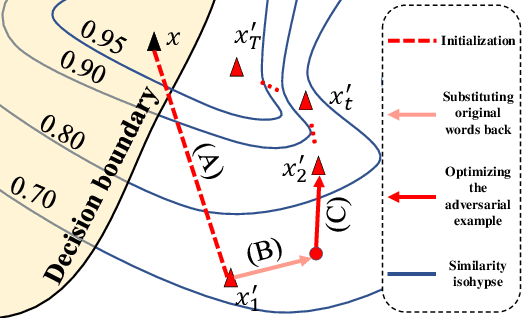
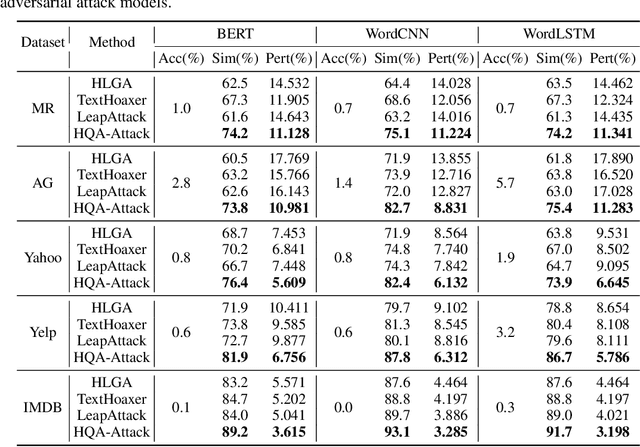
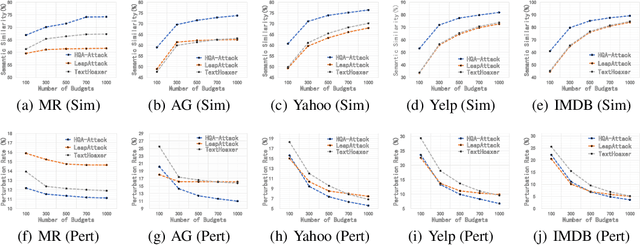

Abstract:Black-box hard-label adversarial attack on text is a practical and challenging task, as the text data space is inherently discrete and non-differentiable, and only the predicted label is accessible. Research on this problem is still in the embryonic stage and only a few methods are available. Nevertheless, existing methods rely on the complex heuristic algorithm or unreliable gradient estimation strategy, which probably fall into the local optimum and inevitably consume numerous queries, thus are difficult to craft satisfactory adversarial examples with high semantic similarity and low perturbation rate in a limited query budget. To alleviate above issues, we propose a simple yet effective framework to generate high quality textual adversarial examples under the black-box hard-label attack scenarios, named HQA-Attack. Specifically, after initializing an adversarial example randomly, HQA-attack first constantly substitutes original words back as many as possible, thus shrinking the perturbation rate. Then it leverages the synonym set of the remaining changed words to further optimize the adversarial example with the direction which can improve the semantic similarity and satisfy the adversarial condition simultaneously. In addition, during the optimizing procedure, it searches a transition synonym word for each changed word, thus avoiding traversing the whole synonym set and reducing the query number to some extent. Extensive experimental results on five text classification datasets, three natural language inference datasets and two real-world APIs have shown that the proposed HQA-Attack method outperforms other strong baselines significantly.
AIDE: A Vision-Driven Multi-View, Multi-Modal, Multi-Tasking Dataset for Assistive Driving Perception
Aug 01, 2023



Abstract:Driver distraction has become a significant cause of severe traffic accidents over the past decade. Despite the growing development of vision-driven driver monitoring systems, the lack of comprehensive perception datasets restricts road safety and traffic security. In this paper, we present an AssIstive Driving pErception dataset (AIDE) that considers context information both inside and outside the vehicle in naturalistic scenarios. AIDE facilitates holistic driver monitoring through three distinctive characteristics, including multi-view settings of driver and scene, multi-modal annotations of face, body, posture, and gesture, and four pragmatic task designs for driving understanding. To thoroughly explore AIDE, we provide experimental benchmarks on three kinds of baseline frameworks via extensive methods. Moreover, two fusion strategies are introduced to give new insights into learning effective multi-stream/modal representations. We also systematically investigate the importance and rationality of the key components in AIDE and benchmarks. The project link is https://github.com/ydk122024/AIDE.
Contributions of Shape, Texture, and Color in Visual Recognition
Jul 19, 2022



Abstract:We investigate the contributions of three important features of the human visual system (HVS)~ -- ~shape, texture, and color ~ -- ~to object classification. We build a humanoid vision engine (HVE) that explicitly and separately computes shape, texture, and color features from images. The resulting feature vectors are then concatenated to support the final classification. We show that HVE can summarize and rank-order the contributions of the three features to object recognition. We use human experiments to confirm that both HVE and humans predominantly use some specific features to support the classification of specific classes (e.g., texture is the dominant feature to distinguish a zebra from other quadrupeds, both for humans and HVE). With the help of HVE, given any environment (dataset), we can summarize the most important features for the whole task (task-specific; e.g., color is the most important feature overall for classification with the CUB dataset), and for each class (class-specific; e.g., shape is the most important feature to recognize boats in the iLab-20M dataset). To demonstrate more usefulness of HVE, we use it to simulate the open-world zero-shot learning ability of humans with no attribute labeling. Finally, we show that HVE can also simulate human imagination ability with the combination of different features. We will open-source the HVE engine and corresponding datasets.
Polytopic Planar Region Characterization of Rough Terrains for Legged Locomotion
Jul 07, 2022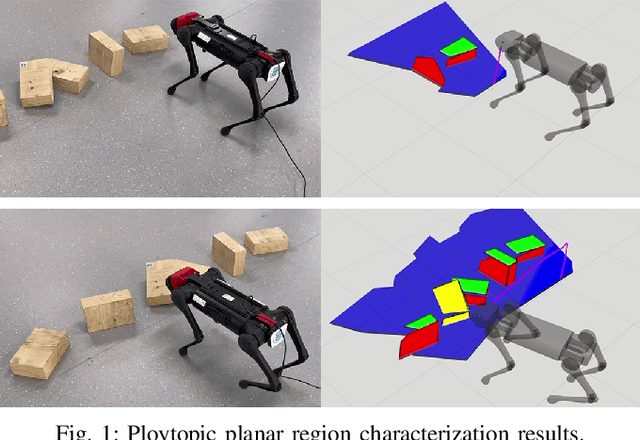


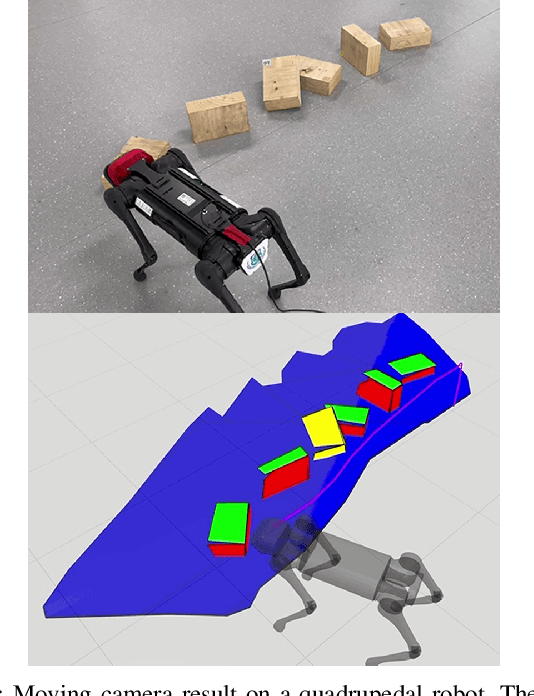
Abstract:This paper studies the problem of constructing polytopic representations of planar regions from depth camera readings. This problem is of great importance for terrain mapping in complicated environment and has great potentials in legged locomotion applications. To address the polytopic planar region characterization problem, we propose a two-stage solution scheme. At the first stage, the planar regions embedded within a sequence of depth images are extracted individually first and then merged to establish a terrain map containing only planar regions in a selected frame. To simplify the representations of the planar regions that are applicable to foothold planning for legged robots, we further approximate the extracted planar regions via low-dimensional polytopes at the second stage. With the polytopic representation, the proposed approach achieves a great balance between accuracy and simplicity. Experimental validations with RGB-D cameras are conducted to demonstrate the performance of the proposed scheme. The proposed scheme successfully characterizes the planar regions via polytopes with acceptable accuracy. More importantly, the run time of the overall perception scheme is less than 10ms (i.e., > 100Hz) throughout the tests, which strongly illustrates the advantages of our approach developed in this paper.
Encouraging Disentangled and Convex Representation with Controllable Interpolation Regularization
Dec 06, 2021



Abstract:We focus on controllable disentangled representation learning (C-Dis-RL), where users can control the partition of the disentangled latent space to factorize dataset attributes (concepts) for downstream tasks. Two general problems remain under-explored in current methods: (1) They lack comprehensive disentanglement constraints, especially missing the minimization of mutual information between different attributes across latent and observation domains. (2) They lack convexity constraints in disentangled latent space, which is important for meaningfully manipulating specific attributes for downstream tasks. To encourage both comprehensive C-Dis-RL and convexity simultaneously, we propose a simple yet efficient method: Controllable Interpolation Regularization (CIR), which creates a positive loop where the disentanglement and convexity can help each other. Specifically, we conduct controlled interpolation in latent space during training and 'reuse' the encoder to help form a 'perfect disentanglement' regularization. In that case, (a) disentanglement loss implicitly enlarges the potential 'understandable' distribution to encourage convexity; (b) convexity can in turn improve robust and precise disentanglement. CIR is a general module and we merge CIR with three different algorithms: ELEGANT, I2I-Dis, and GZS-Net to show the compatibility and effectiveness. Qualitative and quantitative experiments show improvement in C-Dis-RL and latent convexity by CIR. This further improves downstream tasks: controllable image synthesis, cross-modality image translation and zero-shot synthesis. More experiments demonstrate CIR can also improve other downstream tasks, such as new attribute value mining, data augmentation, and eliminating bias for fairness.
A Peek Into the Reasoning of Neural Networks: Interpreting with Structural Visual Concepts
May 01, 2021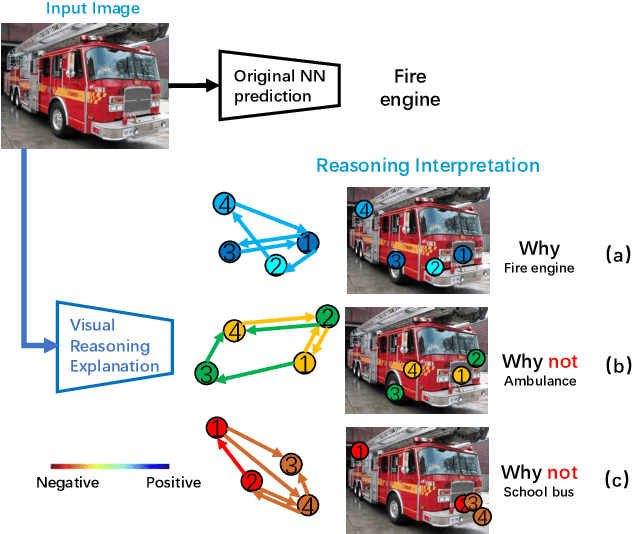



Abstract:Despite substantial progress in applying neural networks (NN) to a wide variety of areas, they still largely suffer from a lack of transparency and interpretability. While recent developments in explainable artificial intelligence attempt to bridge this gap (e.g., by visualizing the correlation between input pixels and final outputs), these approaches are limited to explaining low-level relationships, and crucially, do not provide insights on error correction. In this work, we propose a framework (VRX) to interpret classification NNs with intuitive structural visual concepts. Given a trained classification model, the proposed VRX extracts relevant class-specific visual concepts and organizes them using structural concept graphs (SCG) based on pairwise concept relationships. By means of knowledge distillation, we show VRX can take a step towards mimicking the reasoning process of NNs and provide logical, concept-level explanations for final model decisions. With extensive experiments, we empirically show VRX can meaningfully answer "why" and "why not" questions about the prediction, providing easy-to-understand insights about the reasoning process. We also show that these insights can potentially provide guidance on improving NN's performance.
PerSim: Data-Efficient Offline Reinforcement Learning with Heterogeneous Agents via Personalized Simulators
Mar 17, 2021

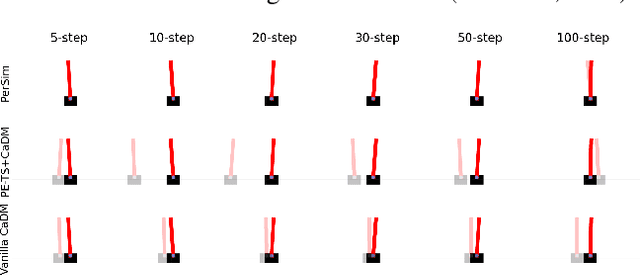
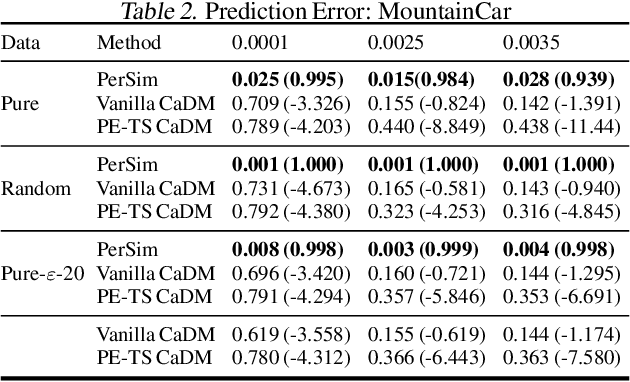
Abstract:We consider offline reinforcement learning (RL) with heterogeneous agents under severe data scarcity, i.e., we only observe a single historical trajectory for every agent under an unknown, potentially sub-optimal policy. We find that the performance of state-of-the-art offline and model-based RL methods degrade significantly given such limited data availability, even for commonly perceived "solved" benchmark settings such as "MountainCar" and "CartPole". To address this challenge, we propose a model-based offline RL approach, called PerSim, where we first learn a personalized simulator for each agent by collectively using the historical trajectories across all agents prior to learning a policy. We do so by positing that the transition dynamics across agents can be represented as a latent function of latent factors associated with agents, states, and actions; subsequently, we theoretically establish that this function is well-approximated by a "low-rank" decomposition of separable agent, state, and action latent functions. This representation suggests a simple, regularized neural network architecture to effectively learn the transition dynamics per agent, even with scarce, offline data.We perform extensive experiments across several benchmark environments and RL methods. The consistent improvement of our approach, measured in terms of state dynamics prediction and eventual reward, confirms the efficacy of our framework in leveraging limited historical data to simultaneously learn personalized policies across agents.
 Add to Chrome
Add to Chrome Add to Firefox
Add to Firefox Add to Edge
Add to Edge